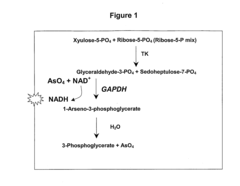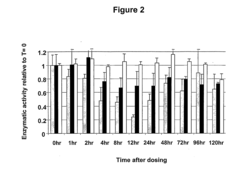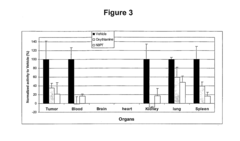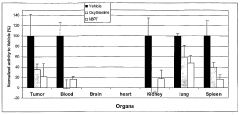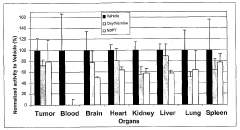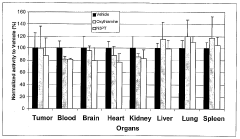Exploring the Pentose Phosphate Pathway: Key Benefits and Mechanisms
Research Background and Objectives
The Pentose Phosphate Pathway (PPP) is a fundamental metabolic pathway in cellular biochemistry, playing a crucial role in carbohydrate metabolism and cellular redox balance. Discovered in the 1950s, this pathway has been the subject of extensive research due to its significance in various biological processes and potential applications in biotechnology and medicine.
The pentose phosphate pathway operates parallel to glycolysis and serves two primary functions: the generation of reducing equivalents in the form of NADPH and the production of ribose-5-phosphate, a precursor for nucleotide synthesis. These functions make the PPP essential for cellular processes such as biosynthesis, antioxidant defense, and cell proliferation.
Over the years, our understanding of the PPP has evolved significantly. Initially viewed as a simple alternative to glycolysis, it is now recognized as a complex and highly regulated pathway with far-reaching implications for cellular metabolism. Recent advancements in metabolomics and systems biology have shed new light on the intricate connections between the PPP and other metabolic pathways, revealing its central role in maintaining cellular homeostasis.
The objectives of exploring the PPP are multifaceted. From a basic science perspective, researchers aim to elucidate the fine details of its regulation and integration with other metabolic networks. This knowledge is crucial for understanding cellular metabolism in both normal and pathological states. In the field of medicine, the PPP has emerged as a potential target for therapeutic interventions in diseases such as cancer, diabetes, and neurodegenerative disorders.
In biotechnology, the PPP presents opportunities for metabolic engineering to enhance the production of valuable compounds. By manipulating the flux through this pathway, researchers seek to optimize the synthesis of pharmaceuticals, biofuels, and other high-value products in microbial cell factories.
The exploration of the PPP also extends to its role in plant metabolism, where it is vital for photosynthesis and stress responses. Understanding the pathway's function in plants could lead to improvements in crop yield and resistance to environmental stresses, addressing critical challenges in agriculture and food security.
As we delve deeper into the intricacies of the PPP, the overarching goal is to harness its potential for improving human health, enhancing industrial biotechnology, and developing sustainable solutions for global challenges. This comprehensive exploration aims to uncover new insights into the pathway's mechanisms, benefits, and potential applications across various fields of science and technology.
Market Demand Analysis
The Pentose Phosphate Pathway (PPP) has garnered significant attention in recent years due to its crucial role in cellular metabolism and potential applications in various industries. Market demand for technologies and products related to the PPP has been steadily increasing, driven by advancements in biotechnology, pharmaceutical research, and the growing focus on sustainable manufacturing processes.
In the pharmaceutical sector, the PPP's involvement in producing NADPH and ribose-5-phosphate has sparked interest in drug development and metabolic disease research. The pathway's potential in enhancing cellular antioxidant defense mechanisms has led to increased demand for PPP-related products in the development of therapies for oxidative stress-related disorders. This has resulted in a surge of research activities and investments in PPP-focused biotechnology startups.
The food and beverage industry has also shown growing interest in PPP-related technologies. The pathway's role in carbohydrate metabolism has led to the development of novel food additives and functional ingredients. Companies are exploring PPP-based solutions for improving the nutritional profile of processed foods and creating new health-promoting products, driving market growth in this sector.
In the field of industrial biotechnology, the PPP's ability to generate reducing power and carbon skeletons for biosynthesis has attracted attention for sustainable manufacturing processes. There is an increasing demand for PPP-optimized microbial strains capable of efficiently producing high-value chemicals and biofuels. This trend aligns with the global shift towards bio-based economies and environmentally friendly production methods.
The agricultural sector has also recognized the potential of PPP in crop improvement. Research into enhancing PPP efficiency in plants has shown promise for increasing crop yields and stress tolerance. This has led to a growing market for PPP-related genetic engineering technologies and bio-stimulants in agriculture.
Furthermore, the cosmetics and personal care industry has begun exploring PPP-based ingredients for anti-aging and skin protection products. The pathway's role in generating antioxidants has sparked interest in developing novel cosmeceuticals, contributing to market expansion in this sector.
As awareness of the PPP's importance grows across multiple industries, the market for related research tools, analytical instruments, and biochemical reagents has also expanded. This has created opportunities for companies specializing in life sciences and laboratory equipment to develop and market PPP-specific products.
Overall, the market demand for PPP-related technologies and products is expected to continue its upward trajectory. The pathway's versatility and its potential applications in addressing global challenges such as healthcare, sustainable production, and food security are likely to drive further investments and innovations in this field.
Current Status and Challenges
The Pentose Phosphate Pathway (PPP) has been extensively studied over the past decades, revealing its crucial role in cellular metabolism. Currently, the PPP is recognized as a fundamental process in glucose metabolism, providing essential molecules for various cellular functions. However, despite significant advancements, several challenges persist in fully understanding and harnessing the potential of this pathway.
One of the primary challenges in PPP research is the complexity of its regulation. The pathway is intricately controlled by multiple factors, including enzyme activity, substrate availability, and cellular redox state. This complexity makes it difficult to predict and manipulate the flux through the pathway accurately. Researchers are still working to elucidate the precise mechanisms that govern PPP regulation under different physiological and pathological conditions.
Another significant challenge lies in the development of effective tools for real-time monitoring of PPP activity in living cells. Current methods often rely on endpoint measurements or require cell disruption, which limits our ability to observe dynamic changes in the pathway. The development of non-invasive, high-resolution techniques for tracking PPP flux in intact cells remains an active area of research.
The interconnectivity of the PPP with other metabolic pathways also presents a challenge in isolating its specific effects. The pathway's products and intermediates are involved in numerous cellular processes, making it difficult to attribute observed phenotypes solely to PPP activity. This interconnectedness necessitates a systems biology approach to fully understand the pathway's role in cellular metabolism.
In the field of biotechnology and metabolic engineering, manipulating the PPP for enhanced production of valuable compounds remains challenging. While the pathway's potential for producing NADPH and ribose-5-phosphate is well-recognized, optimizing its flux without disrupting other essential cellular processes is complex. Researchers are exploring various genetic and metabolic engineering strategies to overcome these limitations and improve the pathway's efficiency for biotechnological applications.
The role of the PPP in disease states, particularly in cancer and neurodegenerative disorders, is an area of intense investigation. While the pathway's involvement in these conditions is established, the exact mechanisms and potential therapeutic interventions are still being explored. Developing targeted approaches to modulate PPP activity in disease contexts without affecting normal cellular function remains a significant challenge.
Lastly, the integration of PPP research with emerging fields such as single-cell analysis and metabolomics presents both opportunities and challenges. These technologies offer unprecedented insights into cellular heterogeneity and metabolic dynamics but require sophisticated data analysis and interpretation methods to fully leverage their potential in understanding the PPP.
Current Pentose Phosphate Pathway Mechanisms
01 NADPH production for cellular redox balance
The pentose phosphate pathway plays a crucial role in generating NADPH, which is essential for maintaining cellular redox balance. This pathway provides reducing power for various biosynthetic processes and helps protect cells against oxidative stress by regenerating antioxidants.- NADPH production for cellular redox balance: The pentose phosphate pathway plays a crucial role in generating NADPH, which is essential for maintaining cellular redox balance. This pathway provides reducing power for various biosynthetic processes and helps protect cells against oxidative stress by regenerating antioxidants.
- Ribose-5-phosphate synthesis for nucleotide production: The pentose phosphate pathway is responsible for producing ribose-5-phosphate, a key precursor for nucleotide synthesis. This is particularly important for rapidly dividing cells, such as cancer cells, which require a constant supply of nucleotides for DNA and RNA synthesis.
- Enhanced biofuel production: Modifying the pentose phosphate pathway in microorganisms can lead to improved production of biofuels and other valuable compounds. By redirecting carbon flux through this pathway, researchers can enhance the yield of desired products in biotechnological applications.
- Metabolic flexibility and adaptation: The pentose phosphate pathway provides metabolic flexibility, allowing cells to adapt to different environmental conditions and nutrient availability. This pathway can be modulated to optimize growth and survival in various organisms, including plants and microorganisms.
- Therapeutic target for disease treatment: The pentose phosphate pathway has emerged as a potential therapeutic target for various diseases, including cancer and metabolic disorders. Modulating this pathway can affect cell proliferation, survival, and metabolism, offering new avenues for drug development and treatment strategies.
02 Ribose-5-phosphate synthesis for nucleotide production
The pentose phosphate pathway is responsible for producing ribose-5-phosphate, a key precursor for nucleotide synthesis. This is particularly important for rapidly dividing cells, such as cancer cells, which require a constant supply of nucleotides for DNA and RNA synthesis.Expand Specific Solutions03 Enhanced biofuel production
Modifying the pentose phosphate pathway in microorganisms can lead to improved production of biofuels and other valuable compounds. By redirecting carbon flux through this pathway, researchers can optimize the synthesis of desired products in biotechnological applications.Expand Specific Solutions04 Metabolic flexibility and adaptation
The pentose phosphate pathway provides metabolic flexibility, allowing cells to adapt to different environmental conditions and nutrient availability. This pathway can be modulated to support various cellular processes, including growth, differentiation, and stress response.Expand Specific Solutions05 Therapeutic target in disease treatment
The pentose phosphate pathway has emerged as a potential therapeutic target for various diseases, including cancer and metabolic disorders. Modulating this pathway can affect cell proliferation, survival, and metabolism, offering new avenues for drug development and treatment strategies.Expand Specific Solutions
Key Players in Pentose Phosphate Pathway Research
The exploration of the Pentose Phosphate Pathway (PPP) is in a mature stage of development, with significant research conducted across academic and industrial sectors. The market for PPP-related applications is substantial, spanning pharmaceuticals, biotechnology, and metabolic engineering. Technologically, the field is well-established, with companies like BASF SE, Ajinomoto Co., Inc., and Evonik Operations GmbH leading industrial applications. Academic institutions such as Zhejiang University and the Centre National de la Recherche Scientifique contribute to fundamental research. The competitive landscape is diverse, with both large corporations and specialized biotech firms like Genomatica, Inc. actively involved in developing PPP-based solutions for various industries.
BASF SE
Ajinomoto Co., Inc.
Key Innovations in Pentose Phosphate Pathway
- A fluorescence-based assay that measures the enzymatic activities of these enzymes in cell lysates, tissues, and blood, providing increased sensitivity and convenience by eliminating the need for enzyme isolation and reducing sample manipulation, allowing for high-throughput analysis.
- A fluorescence-based assay method that measures the activity of transketolase, alpha-ketoglutarate dehydrogenase, pyruvate dehydrogenase, and glucose-6-phosphate dehydrogenase enzymes by monitoring the production of NADH or NADPH, allowing for more sensitive and rapid detection without the need for extensive sample preparation, enabling monitoring of enzymatic levels over time and optimizing drug dosing and scheduling.
Metabolic Engineering Applications
The Pentose Phosphate Pathway (PPP) offers significant potential for metabolic engineering applications, particularly in the production of valuable biochemicals and biofuels. This pathway plays a crucial role in generating NADPH and pentose sugars, which are essential for various cellular processes and biosynthetic reactions.
One of the primary applications of PPP in metabolic engineering is the enhancement of NADPH production. NADPH is a critical cofactor for many biosynthetic reactions, including the production of fatty acids, amino acids, and secondary metabolites. By manipulating the PPP, engineers can increase the availability of NADPH, thereby improving the efficiency of these biosynthetic processes. This approach has been successfully employed in the production of various high-value compounds, such as terpenoids, flavonoids, and polyketides.
Another important application is the optimization of pentose sugar metabolism. Many industrial microorganisms struggle to efficiently utilize pentose sugars, which are abundant in lignocellulosic biomass. By engineering the PPP, researchers can improve the ability of these organisms to metabolize pentoses, leading to more efficient conversion of biomass into valuable products. This is particularly relevant in the production of biofuels and biochemicals from renewable feedstocks.
The PPP also offers opportunities for improving stress tolerance in engineered organisms. The pathway's role in generating reducing power and antioxidants makes it a valuable target for enhancing cellular resistance to oxidative stress. This can lead to more robust industrial strains capable of withstanding harsh fermentation conditions or toxic byproducts.
Furthermore, the PPP can be leveraged to create novel metabolic routes for the production of non-native compounds. By introducing new enzymes or redirecting metabolic flux through the pathway, engineers can create synthetic pathways for the production of chemicals that are not naturally synthesized by the host organism. This approach has been used to produce a wide range of compounds, from bioplastics to pharmaceutical precursors.
In the field of bioremediation, the PPP's ability to generate reducing power can be harnessed to enhance the degradation of environmental pollutants. Engineered microorganisms with an optimized PPP can more effectively break down complex organic compounds, offering potential solutions for environmental cleanup.
As metabolic engineering techniques continue to advance, the PPP remains a key target for optimization and manipulation. Its central role in cellular metabolism and its flexibility in generating important precursors make it an invaluable tool for creating more efficient and versatile biocatalysts for industrial applications.
Pentose Phosphate Pathway in Disease and Therapeutics
The Pentose Phosphate Pathway (PPP) plays a crucial role in various diseases and offers potential therapeutic targets. In cancer, the PPP is often upregulated, providing cancer cells with ribose-5-phosphate for nucleotide synthesis and NADPH for redox balance. This metabolic reprogramming supports rapid proliferation and survival under oxidative stress. Targeting key enzymes in the PPP, such as glucose-6-phosphate dehydrogenase (G6PD), has shown promise in inhibiting tumor growth and enhancing chemosensitivity.
In neurodegenerative disorders like Alzheimer's and Parkinson's diseases, PPP dysfunction contributes to oxidative stress and neuronal death. Enhancing PPP activity through pharmacological interventions or genetic modulation may offer neuroprotective benefits by improving NADPH production and antioxidant defenses. Recent studies have explored the use of PPP modulators to mitigate neurodegeneration in animal models.
Metabolic disorders, including diabetes, are also linked to PPP alterations. In diabetes, increased flux through the PPP can contribute to complications by generating excess NADPH, which fuels reactive oxygen species production. Conversely, PPP activation in certain tissues may improve glucose homeostasis and insulin sensitivity. This dual role highlights the complexity of targeting the PPP in metabolic diseases and the need for tissue-specific approaches.
Autoimmune diseases present another area where PPP modulation shows therapeutic potential. The pathway's role in supporting T cell activation and differentiation makes it an attractive target for immunomodulation. Inhibiting specific PPP enzymes has demonstrated efficacy in reducing inflammation and autoantibody production in preclinical models of lupus and rheumatoid arthritis.
Emerging research has also implicated the PPP in cardiovascular diseases. Alterations in PPP flux can affect vascular function, lipid metabolism, and atherosclerosis progression. Therapeutic strategies aimed at optimizing PPP activity in cardiovascular tissues are being explored to improve endothelial function and reduce oxidative stress-induced damage.
As our understanding of the PPP's role in disease pathogenesis deepens, novel therapeutic approaches continue to emerge. These include the development of selective PPP enzyme inhibitors, metabolic modulators that influence pathway flux, and gene therapy approaches targeting key PPP components. The challenge lies in achieving tissue-specific modulation of the PPP to maximize therapeutic benefits while minimizing systemic side effects.

